Flora and Fauna
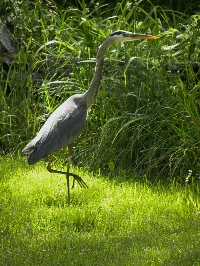 iNaturalist
iNaturalist
Discover and track the species that make their home in and around Otty Lake. We invite you to help us create an ongoing catalog of the wildlife for the area. This library will help us gain insight into the distribution and seasonality of the organisms in our region. It will help the scientific community through records of wildlife movements, invasive species, species at risk as well as sharing observations among friends. Visit the website or download the app.
https://inaturalist.ca/projects/otty-lake
If you need additional direction on how to use iNaturalist, check these resources:
Once you have an account, you can message project coordinators Kit Muma and Bruce Smith through their iNaturalist usernames. Bruce is “Parasitengona” and Kit is “Trichodezia” .
Plant and Animal Lists
Consult the appendices of the 2007 State of the Lake report to see complete lists of species noted around Otty Lake:
>> Plants
>> Submergent and Emergent Vegetation
>> Birds
>> Fish
>> Mammals, Reptiles and Amphibians
>> Species at Risk
A few other species have been noted since the above lists were produced:
Bushes and Shrubs – Maple Leaf Viburnum Viburnum Acerifolium
Deciduous Trees – Choke Cherry Pruns Verginiana
Understory Plants – Yellow Lady’s Slipper Cypripedium calceolus
Understory Plants – exotic – Bladder Campion Selene Cucabalus
Nature and the OLA
In past years, the OLA has organized Bio Blitz’s as well as nature hikes, led by Roger Nuttall. Some turtle identification and wetland workshops have also taken place. Check the Events page to see if one is in the planning stages, or let us know if there is something you think would be of interest to other lakers.
Species of General Interest | Invasive Species | Species at Risk
Species of General Interest
A few species of general interest to residents and cottagers are noted below.
Black Bears | Grey Ratsnake | Loons | Wild Turkeys | Green Algae | Clams |
These species are considered invasive. Their descriptions are on the invasive species page:
Eurasian Milfoil | Rusty Crayfish | Banded Mysterysnail | Zebra Mussels | Spiny Water Fleas | European Frogbit
See a page of resources on the Spongy Moth.
Loons
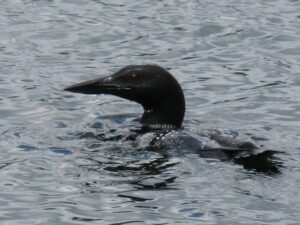 Otty Lake is home to several families of loons, however, it appears that fewer loons are choosing Otty Lake, and those living on the lake are producing significantly fewer young. In 2017, the five mating pairs only produced one chick that survived to maturity. In 2018, of the five mating pairs, two were known to have nested, but no chicks survived. Kyla Haley is the lake’s official “Loon Monitor”. She would like to be advised of loon sitings, which are them compiled on a google map. See the 2018 map.
Otty Lake is home to several families of loons, however, it appears that fewer loons are choosing Otty Lake, and those living on the lake are producing significantly fewer young. In 2017, the five mating pairs only produced one chick that survived to maturity. In 2018, of the five mating pairs, two were known to have nested, but no chicks survived. Kyla Haley is the lake’s official “Loon Monitor”. She would like to be advised of loon sitings, which are them compiled on a google map. See the 2018 map.
Keeping Loons Safe
When boating:
watch for loons and keep your distance
slow down if you suspect you are near diving loons
if you discover a nest, move away
enjoy loons from a distance with binoculars – don’t come too close
When fishing:
do not use lead based fishing tackle, it is fatal if ingested by loons. Note it is illegal to use or possess lead fishing sinkers or jigs in Canada’s National Parks and National Wildlife Areas.
reel in around loons! Loons may die from becoming tangled in fishing line
Dispose of monofilament properly
Avoid fishing for prolonged periods in secluded coves where loons may be nesting or feeding
On land:
don’t allow your pets to run wild along shore and harass wildlife
Wild Turkeys
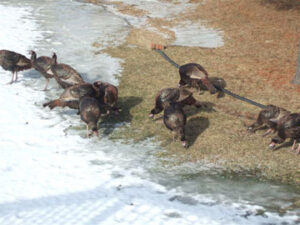 Wild turkeys have been reintroduced to Eastern Ontario, including Lanark County, since the mid-80s to be a game bird for hunting purposes. The birds have been increasing in numbers ever since. A flock of 30 wild turkey appeared in Maple Glen Estates one year and stayed throughout the winter. They come quite boldly right up to residents’ front doors. A word of caution: Give these creatures their space, as they can become quite nasty if they feel threatened, and they are extremely aggressive in protecting their young. Ottawa Sun story on wild turkeys and forests.
Wild turkeys have been reintroduced to Eastern Ontario, including Lanark County, since the mid-80s to be a game bird for hunting purposes. The birds have been increasing in numbers ever since. A flock of 30 wild turkey appeared in Maple Glen Estates one year and stayed throughout the winter. They come quite boldly right up to residents’ front doors. A word of caution: Give these creatures their space, as they can become quite nasty if they feel threatened, and they are extremely aggressive in protecting their young. Ottawa Sun story on wild turkeys and forests.
Black Bears
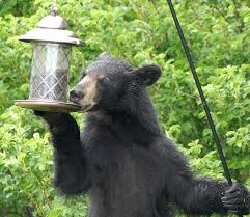 There are frequent black bear sitings in Eastern Ontario, and many around Otty Lake, with the local population being particularly active in 2017. However, we have no reports of any human-bear conflicts.
There are frequent black bear sitings in Eastern Ontario, and many around Otty Lake, with the local population being particularly active in 2017. However, we have no reports of any human-bear conflicts.
Generally, bears want to avoid humans. Most encounters are not aggressive and attacks are rare. If you have questions or feel a bear has become a nuisance on your property, contact the Ministry of Natural Resources and Forestry Bear Wise hotline at 1-866-514-2327.
The MNRF Bear Wise program provides information on how not to attract bears to your property, what to do if you see a bear in the wild, and what to do in the unlikely event of an conflict. The OLA organized a black bear information session in September 2017 to educate local residents on how to avoid attracting them to your (and thus your neighbour’s ) property. Takeaways from the session are listed here, and Wildlife Technician Trevor Horvatin’s comments were included in our October 2017 newsletter.
Additional information is available on the Ontario Ministry of Natural Resources and Forestry’s “Bear Wise” website.
Grey Ratsnake
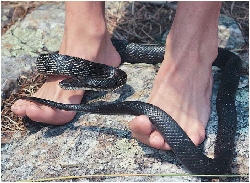 Regulations are in place to protect the habitat of the threatened grey ratsnake. This is Ontario’s largest snake, but not to worry, they are non-venomous and non-aggressive. They can often be seen sunning themselves on roads around Otty Lake. The north shore and southwest shore have been identified as ratsnake habitat because of verified observations of the snakes and their hibernacula, where they hibernate for six months of the year. Activities in their habitat can continue as long as the function of these areas for the species are maintained and the species are not killed, harmed or harassed. Do not remove or alter hibernacula, and avoid disturbing any egg-laying sites you may encounter in compost piles or rotting logs. Read stories in our October 2013 newsletter and in the July 2017 newsletter. Your family may be interested in adopting a grey ratsnake through the Friends of Murphy’s Point.
Regulations are in place to protect the habitat of the threatened grey ratsnake. This is Ontario’s largest snake, but not to worry, they are non-venomous and non-aggressive. They can often be seen sunning themselves on roads around Otty Lake. The north shore and southwest shore have been identified as ratsnake habitat because of verified observations of the snakes and their hibernacula, where they hibernate for six months of the year. Activities in their habitat can continue as long as the function of these areas for the species are maintained and the species are not killed, harmed or harassed. Do not remove or alter hibernacula, and avoid disturbing any egg-laying sites you may encounter in compost piles or rotting logs. Read stories in our October 2013 newsletter and in the July 2017 newsletter. Your family may be interested in adopting a grey ratsnake through the Friends of Murphy’s Point.
In the summer of July 2017, Board Member Monika Savage undertook an informal mapping survey of grey rat snakes around the lake.
Clams
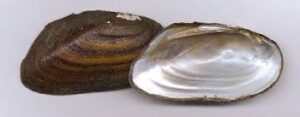 Have you noticed that the clams that were so prevalent in the lake a few decades ago aren’t so plentiful? Muskrats enjoyed this food source, one species being the Eastern elliptio shown here. But there is a “mussel crisis” in Ontario. Of the 41 native mussel species found in Ontario, 11 are endangered and one threatened. And one of the reasons is the zebra mussel. Besides out-competing the native mussels for food and oxygen and spreading disease, the zebra mussels attach themselves to freshwater clam shells and weigh them down, or block openings so that it is difficult for the clams to feed or burrow. There have been observations that muskrats in particular are now feeding on zebra mussels. Muskrats will discard the shells in discreet piles or middens. Read more about Ontario’s mussel crisis in ON Nature.
Have you noticed that the clams that were so prevalent in the lake a few decades ago aren’t so plentiful? Muskrats enjoyed this food source, one species being the Eastern elliptio shown here. But there is a “mussel crisis” in Ontario. Of the 41 native mussel species found in Ontario, 11 are endangered and one threatened. And one of the reasons is the zebra mussel. Besides out-competing the native mussels for food and oxygen and spreading disease, the zebra mussels attach themselves to freshwater clam shells and weigh them down, or block openings so that it is difficult for the clams to feed or burrow. There have been observations that muskrats in particular are now feeding on zebra mussels. Muskrats will discard the shells in discreet piles or middens. Read more about Ontario’s mussel crisis in ON Nature.
Green Algae
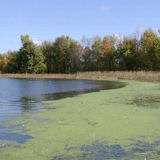 Green algae is naturally occurring, and is not considered invasive, although there have been an increased amount of blooms of green algae at Otty Lake over the past five years. The distinction is that lower amounts of algae can be distributed throughout the water column and are not readily apparent. It is when the algae become more abundant that they form algal blooms, which are unappealing to human water users. Later in their life cycle, decomposing aquatic plants and algae uses up too much oxygen, degrading the aquatic ecosystem, leading to changes such as fish kills.
Green algae is naturally occurring, and is not considered invasive, although there have been an increased amount of blooms of green algae at Otty Lake over the past five years. The distinction is that lower amounts of algae can be distributed throughout the water column and are not readily apparent. It is when the algae become more abundant that they form algal blooms, which are unappealing to human water users. Later in their life cycle, decomposing aquatic plants and algae uses up too much oxygen, degrading the aquatic ecosystem, leading to changes such as fish kills.
There are many types of algae, but the algal blooms at Otty are a green filamentous type. Two species of green algae found at Otty are Spirogyra and Mougeotia. Algae are at the bottom of the food chain, and how well they do depends on temperature, light and nutrients. They use chlorophyll to produce their food. They are useful as they take in nitrogen (from animal feces), are a food source for other animals, and when dense can provide cover for other animals. However, excess nutrients, particularly phosphorus, can make them grow very quickly. So Otty Lake dwellers are being asked to reduce the amount of phosphorus they allow to enter the lake via fertilizers, phosphates and wood ash, and create a shoreline buffer so less of this nutrient runs off into the lake. In 2014, a collaborative group received Trillium funding to study aquatic plants and algae in this area, and Otty was one of the study lakes.
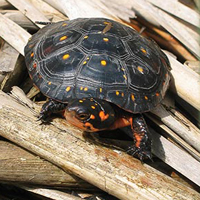
Species at Risk
More than 200 plant and animal species are at risk in Ontario, and 26 species are at risk in Lanark County. These include a number of birds, fish, turtles, snakes, insects, lichens, lizards and plants.
Species at risk are classified into five categories, based on the degree of risk it faces:
Extinct: no longer lives anywhere in the world
Extirpated: lives somewhere in the world, and at one time lived in the wild in Ontario, but no longer lives in the wild in Ontario
Endangered: lives in the wild in Ontario but is facing imminent extinction or extirpation
Threatened: lives in the wild in Ontario, is not endangered, but is likely to become endangered if steps are not taken to address factors threatening it
Special concern: lives in the wild in Ontario, is not endangered or threatened, but may become threatened or endangered due to a combination of biological characteristics threats
More on Plants and Wildlife
More About Loons
A tip sheet from the Maine Audubon Society including behaviour, keeping loons safe, and a loon lifecycle calendar.
Loon calls, how they fly, migration etc. from the Journey North Series.
Invasive Species Hotline
Think you’ve found an invasive species or want more information on invasive species? Contact the Invading Species Hotline 1-800-563-7711.
Wood Duck Nest Box Maintenance
If you have one of these boxes, be sure to clean it out and put in a fresh supply of wood shavings (not sawdust) this fall or winter. Cavity-nesting ducks do not carry nesting materials and won’t choose an empty box. Boxes are often not used the first year, but a duck may check it out for use the next year, so make sure it passes inspection!

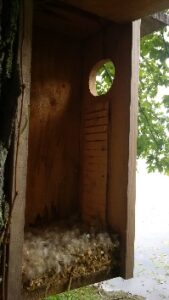
Learn to Recognize Wild Parsnip
Wild parsnip, which is spreading rapidly in Eastern Ontario. People coming in contact with the plant’s sap have developed severe skin irritations. This plant has a yellow umbrella-like top and saw tooth leaves. Wild parsnip can be controlled by pulling or digging, or by mowing if done at the right stage of its development. Wear protective clothing and be extremely cautious when handling it, and be wary of picking wild flowers.
LGL Health Unit on poisonous weeds
BioBlitz
A BioBlitz is an event that focuses on finding and identifying as many local species as possible in a specific area over a short period of time. Otty Lake has been the site of two such events:
Spring 2010 on private properties just east of Otty Lake along Jebb’s Creek.
BioBlitz 2010 Report
Mid-summer 2012 in the southwest corner of Otty Lake on the site of Camp Whispering Pines and in the adjacent Mica Mines Conservation Area.
BioBlitz 2012 Report